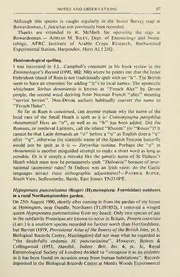
Hentomological spelling PDF
Preview Hentomological spelling
— NOTES AND OBSERVATIONS 97 Although this species is caught regularly in the Insect Survey trap at Rowardennan, f.fuscahas not previously been recorded. Thanks are extended to R. McMath for operating the trap at — Rowardennan. Adrian M. Riley, Dept. of Entomology and Nema- tology, AFRC Institute of Arable Crops Research, Rothamsted Experimental Station, Harpenden, Herts AL5 2JQ. Hentomological spelling. I was interested in J.L. Campbell's comment in his book review in the Entomologist's Record (1990, 102: 308) where he points out that the Inner Hebridean island of Rum is not traditionally spelt with an "h". The British seem to have an obsession for adding "h"s to local names. The apomictic whitebeam Sorbus devoniensis is known as "French Ales" by Devon people, the second word deriving from Norman French "alies" meaning "service berries". Non-Devon authors habitually convert the name to "French Hales". So far as Rum is concerned, can anyone explain why the name of the local race of the Small Heath is spelt as it is: Coenonympha pamphilus rhoumensisl Here an "o", as well as an "h" has been added. Did the Romans, or medieval Latinists, call the island "Rhoum" (or "Roum")? It cannot be that Latin demands an "o" before a "u" as English does a "u" after "q", otherwise the scientific name of the Spanish Festoon butterfly — would not be spelt as it is Zerynthia rumina. Perhaps the "o" in rhoumensis is another misguided attempt to make a short word as long as possible. Or is it simply a mistake like the generic name of St Dabeoc's Heath which must now be permanently spelt ''Daboecia"because ofinter- natibnal taxonomic rules? St Dabeoc was an Irish saint: do the Gaehc languages attract these orthographic adjustments? Patrick Roper, South View, Sedlescombe, Battle, East Sussex TN33 OPE. Hypoponera punctatissima (Roger) (Hymenoptera: Formicidae) outdoors in a ruraf Northamptonshire garden. On 25th August 1990, shortly after coming in from the garden ofmy house at Hemington, near Oundle, Northants (TL091852), I removed a winged queen Hypoponerapunctatissima from my beard. Only two species of ant in the subfamily Ponerinae are known to occur in Britain, Poneracoarctata (Latr.) is a southern species recorded no further north than Hertfordshire, but Barrett (1979, ProvisionalAtlas ofthe Insects ofthe British Isles, pt.5. Biological Records Centre, Huntingdon) did not map what he regarded as "the doubtfully endemic H. punctatissima'". However, Bolton & Collingwood (1953, Handbk, Indent. Brit. Ins. 6, pt. 3c, Royal Entomological Society of London) decided to "recognise it as an endemic as it has been found on occasion away from human habitations". Records deposited in the Biological Records Centre at Monks Woods Experimental
